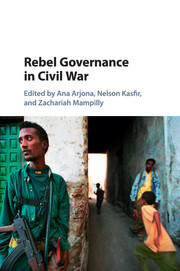Book contents
- Half title page
- Title page
- Copyright page
- Contents
- Contributors
- Book part
- 1 Introduction
- 2 Rebel Governance – Constructing a Field of Inquiry: Definitions, Scope, Patterns, Order, Causes
- 3 Del Gobierno de Abajo al Gobierno de Arriba …and Back: Transitions to and from Rebel Governance in Latin America, 1956–1990
- 4 Performing the Nation-State: Rebel Governance and Symbolic Processes1
- 5 Rebel Diplomacy: Theorizing Violent Non-State Actors’ Strategic Use of Talk
- 6 Rebel Governance During the Greek Civil War, 1942–1949
- 7 Comparing Rebel Rule Through Revolution and Naturalization: Ideologies of Governance in Naxalite and Naga India
- 8 Myths Set in Motion: The Moral Economy of Mai Mai Governance
- 9 Civilian Resistance to Rebel Governance1
- 10 Dialogue Direct:Rebel Governance and Civil Order in Northern Côte d’Ivoire
- 11 The Rebel State in Society: Governance and Accommodation in Aceh, Indonesia1
- 12 Organization and Governance: The Evolution of Urban Militias in Medellín, Colombia
- 13 Predatory Rebellions and Governance: The National Patriotic Front of Liberia, 1989–1992
- 14 Conclusion
- Index
- References
13 - Predatory Rebellions and Governance: The National Patriotic Front of Liberia, 1989–1992
Published online by Cambridge University Press: 05 October 2015
- Half title page
- Title page
- Copyright page
- Contents
- Contributors
- Book part
- 1 Introduction
- 2 Rebel Governance – Constructing a Field of Inquiry: Definitions, Scope, Patterns, Order, Causes
- 3 Del Gobierno de Abajo al Gobierno de Arriba …and Back: Transitions to and from Rebel Governance in Latin America, 1956–1990
- 4 Performing the Nation-State: Rebel Governance and Symbolic Processes1
- 5 Rebel Diplomacy: Theorizing Violent Non-State Actors’ Strategic Use of Talk
- 6 Rebel Governance During the Greek Civil War, 1942–1949
- 7 Comparing Rebel Rule Through Revolution and Naturalization: Ideologies of Governance in Naxalite and Naga India
- 8 Myths Set in Motion: The Moral Economy of Mai Mai Governance
- 9 Civilian Resistance to Rebel Governance1
- 10 Dialogue Direct:Rebel Governance and Civil Order in Northern Côte d’Ivoire
- 11 The Rebel State in Society: Governance and Accommodation in Aceh, Indonesia1
- 12 Organization and Governance: The Evolution of Urban Militias in Medellín, Colombia
- 13 Predatory Rebellions and Governance: The National Patriotic Front of Liberia, 1989–1992
- 14 Conclusion
- Index
- References
Summary
Rebels focused on profit sometimes provide civilian governance, contrary to the expectations of political economy and “new war” analysts. But the governance that these rebellions supply differs considerably from that of insurgents trying to win the hearts and minds of non-combatants. Charles Taylor’s NPFL controlled most of Liberia between 1990 and 1992. The chaotic environment that it created would appear to help substantiate that a “greed” approach means rebels do not govern. In fact, it was integral to maintaining a distinctive political regime. Its war was not “new” and the spaces it controlled were not “ungoverned.” Violence and patronage were integral to the NPFL regime. In both respects NPFL leaders extended political practices they had learned in prewar Liberia, especially from President Samuel Doe’s regime. Violence served accumulation. Maintaining insecurity facilitated personal loyalty to political leaders and military commanders. Profits from commercial ventures went into the pockets of leaders and commanders. The veneer of a government administration, legislature, and courts was constructed primarily for an unsuccessful effort to gain international recognition and for additional opportunities to collect bribes.
- Type
- Chapter
- Information
- Rebel Governance in Civil War , pp. 265 - 285Publisher: Cambridge University PressPrint publication year: 2015
References
- 19
- Cited by



